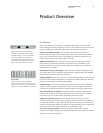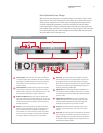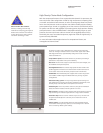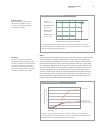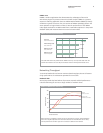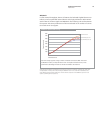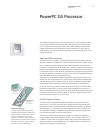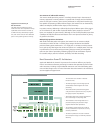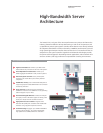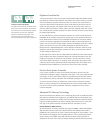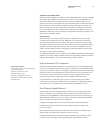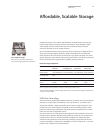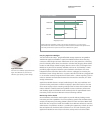
PowerPC G5 Processor
The breakthrough performance of the 64-bit PowerPC G5 is now available to Apple
server customers. With 64-bit-wide data paths and registers, this revolutionary pro-
cessor can address vast amounts of main memory, while handling multiple 64-bit
integer and double-precision floating-point math calculations in a single pass. Its
wide execution core manages immense operations in parallel, supporting up to 215
in-flight instructions.
Apple and IBM Partnership
The PowerPC G5 is the product of a long-standing partnership between Apple and
IBM, two companies committed to innovation and customer-driven solutions. In 1991,
they co-created a PowerPC architecture that could support both 32-bit and 64-bit
instructions. Leveraging this design, Apple went on to bring 32-bit RISC processing to
desktop and portable computers, while IBM focused on developing 64-bit processors
for enterprise servers. The new PowerPC G5 represents a convergence of these efforts:
Its design is based on the PowerPC instruction set, as well as the POWER Architecture
that drives IBM’s top-of-the-line enterprise servers.
The PowerPC G5 is fabricated in IBM’s new $3 billion, state-of-the-art facility in East
Fishkill, New York. To get electronics so small requires miniaturization breakthroughs,
and IBM’s dedication to scientific research has made these advances possible. With
industry-leading build, assembly, and test technology, IBM uses a 90-nanometer
process to produce the PowerPC G5. More than 58 million silicon-on-insulator (SOI)
transistors and eight layers of copper interconnects enable this new processor to
deliver tremendous performance. The use of these advanced technologies also means
the PowerPC G5 draws less power and produces less heat—allowing Apple to pack
two 64-bit 2GHz processors in a 1U form factor.
64-Bit Computing Power
The labels “32-bit” and “64-bit”characterize the width of a microprocessor’s data
stream, which is a function of the sizes of its registers and the internal data paths
that feed the registers. A 64-bit processor moves data and instructions along 64-bit-
wide data paths—compared with the 32-bit-wide paths on 32-bit processors, such
as the Pentium 4 and Xeon. In addition, 64-bit processors have wide registers that
can store 64-bit numbers as well as 32-bit numbers.
The leap from 32-bit to 64-bit processing represents an exponential advance in
computing power.With 32-bit registers, a processor has a dynamic range of 2
32
,or
4.3 billion—which means it can express integers from 0 to 4.3 billion. With 64-bit
registers, the dynamic range catapults to 2
64
, or 18 billion billion—4.3 billion times
larger than the range of a 32-bit processor.
11
Technology Overview
Xserve G5
4.3 billion times bigger
To grasp the enormous leap from 32-bit
to 64-bit processing, imagine equating the
range of numbers a processor can express
with a two-dimensional area. A 32-bit
processor can express a range of integers
equal to the size of a postcard, while a 64-bit
processor can express a range of integers
larger than the island of Manhattan.
32-bit processing
Postcard =
24 in.
2
(155 cm
2
)
64-bit processing
Manhattan =
22 mi.
2
(57 km
2
)
AND
ND
ND
ND
D




